Making a gluten free sourdough starter couldn’t be easier. Start with a few simple ingredients, a little time and patience, soon you’ll be making delicious homemade gluten free sourdough bread, pizza, pancakes, and waffles! This recipe is vegetarian and vegan.
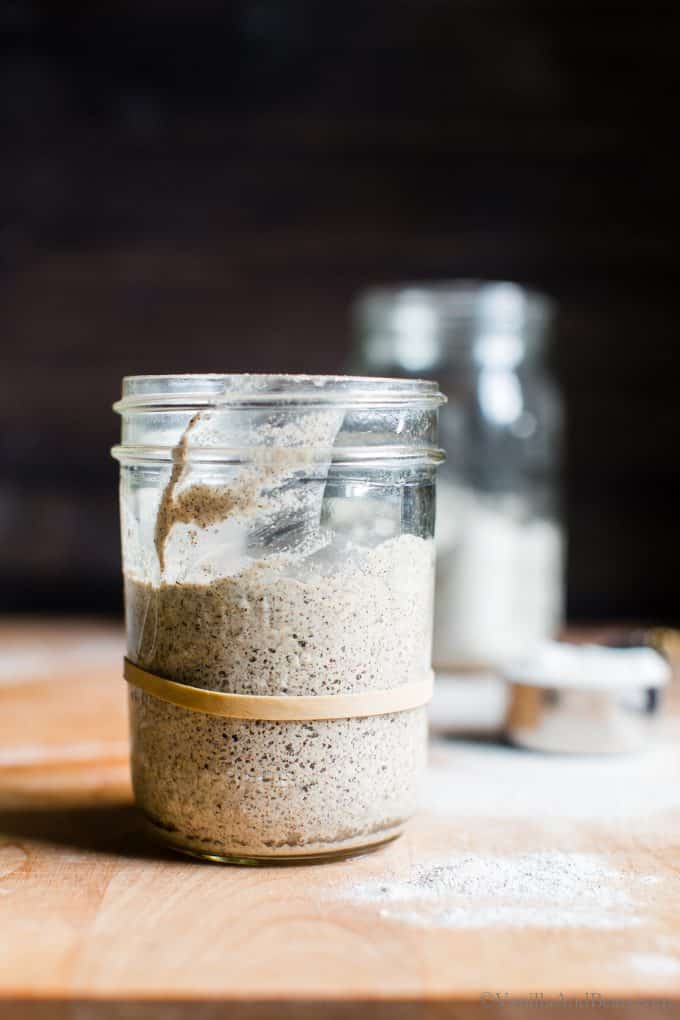
Table of Contents
A Gluten Free Journey
I started my gluten free sourdough journey in the summer of 2018. At the time I had just recently become proficient at sourdough bread when my doctor declared she wanted me to give a gluten free trial a go. And so the journey began.
I am eating gluten again, but through the development of this gluten free starter, and consequently gluten free multigrain sourdough bread and gluten free sourdough pizza, the Vanilla And Bean community has shown interest. Also, I’ve created gluten free sourdough pancakes and waffles with this sourdough starter, using whole grain flours, that taste over the top!
Gluten free sourdough starter is simple to make, but it took a bit of trial and error for me to get to this point. While it’s similar to developing a glutenous sourdough starter, I found some gluten free flours to be more reliable than others in producing a consistent result.
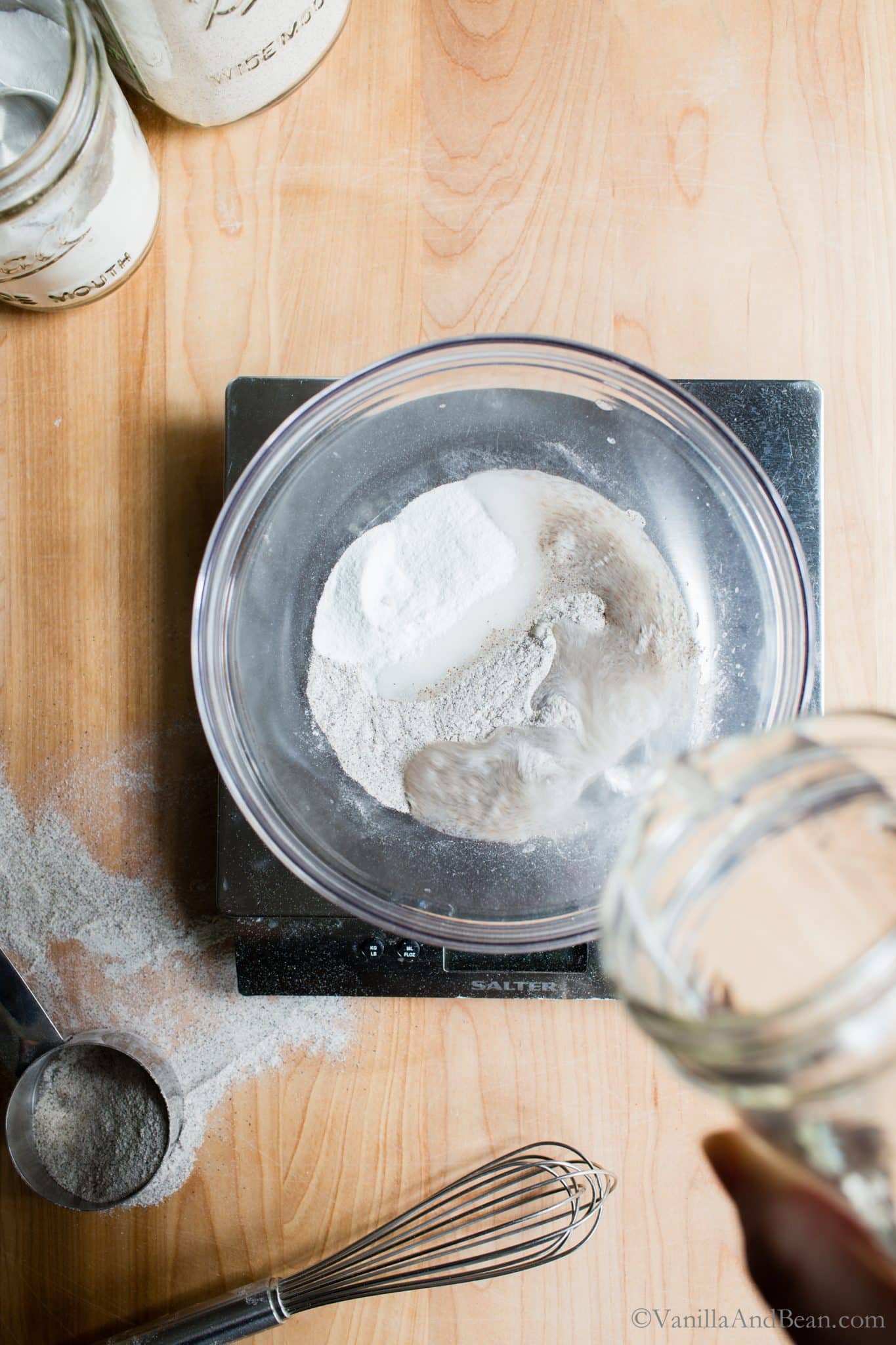
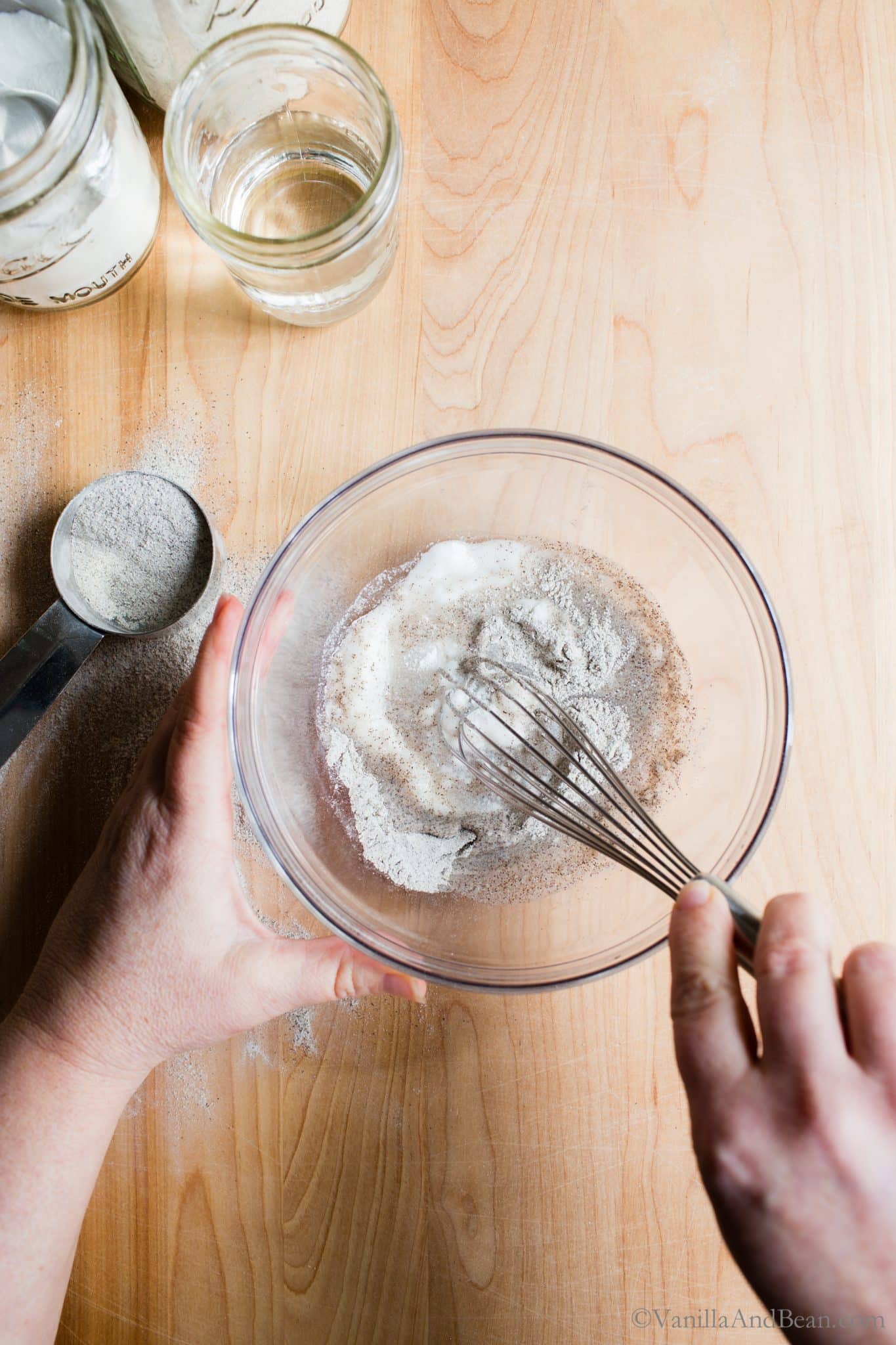

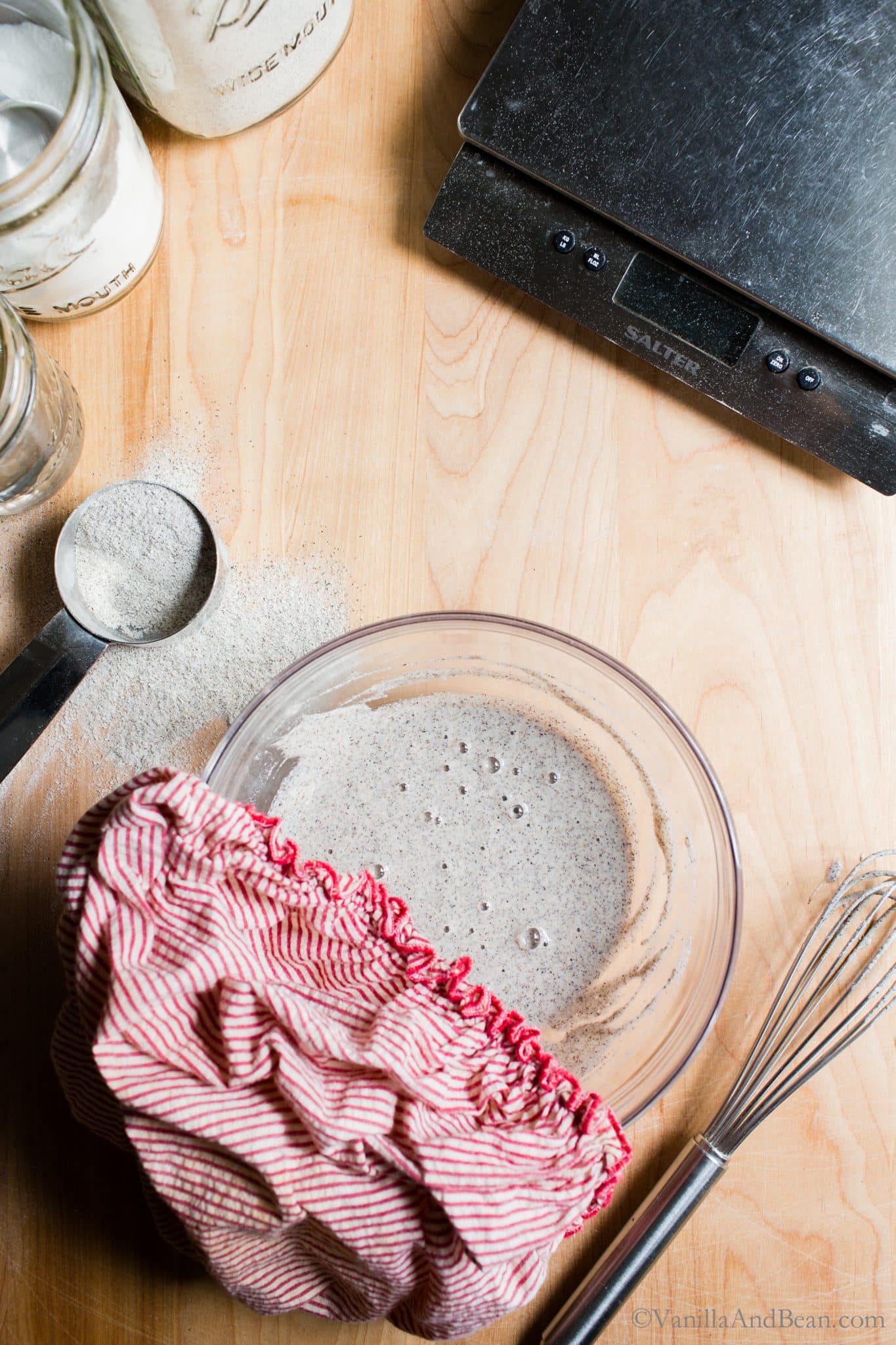
How to Make a Gluten Free Sourdough Starter
This simple recipe generally takes about 5-7 days to complete, but it could take longer. You’ll think about it more than the time it takes to make it: checking on it periodically, looking for bubbles, taking a whiff for a bit of that sweet and sour aroma we’re after. The key is patience and consistency (see recipe card below for details).
- Day 1: In a medium glass bowl or jar, whisk buckwheat or brown rice flour with sweet rice flour and water. Lid or cover with a damp tea towel and set aside at room temperature 24 hours.
- Day 2: Take a portion of the previous days mix (discard the leftover), and in a clean jar or bowl whisk in previous days mix, water and buckwheat and sweet rice flour. Lid or cover with a damp tea towel and set aside at room temperature for 24 hours.
at about day three or four, your starter will begin to smell unpleasant, like sweaty socks. keep going… it will change for the better!
- Day 3 through 6…or 7 (or beyond): Repeat day two until the mixture becomes puffy, has a pleasant sweet-sour aroma and bubbles begin to form under the surface. How many days it takes to complete to get to this point depends on ambient temperature and available, naturally occurring yeast and bacteria. Six to seven days has been my experience.
- Note: Time mentioned here is a guide rather than a determining factor for when the starter is ready. Use the cues and your senses to determine when it’s ready. It may take longer than seven days.
It’s ready when it’s ready.
- Once the starter is puffy, has a sweet-sour aroma and bubbles are present under the surface (see pictures below), your initial starter is ripe or ready.
- Last, to keep your starter healthy and strong, you’ll need to refresh it, or feed it before using it in a recipe.
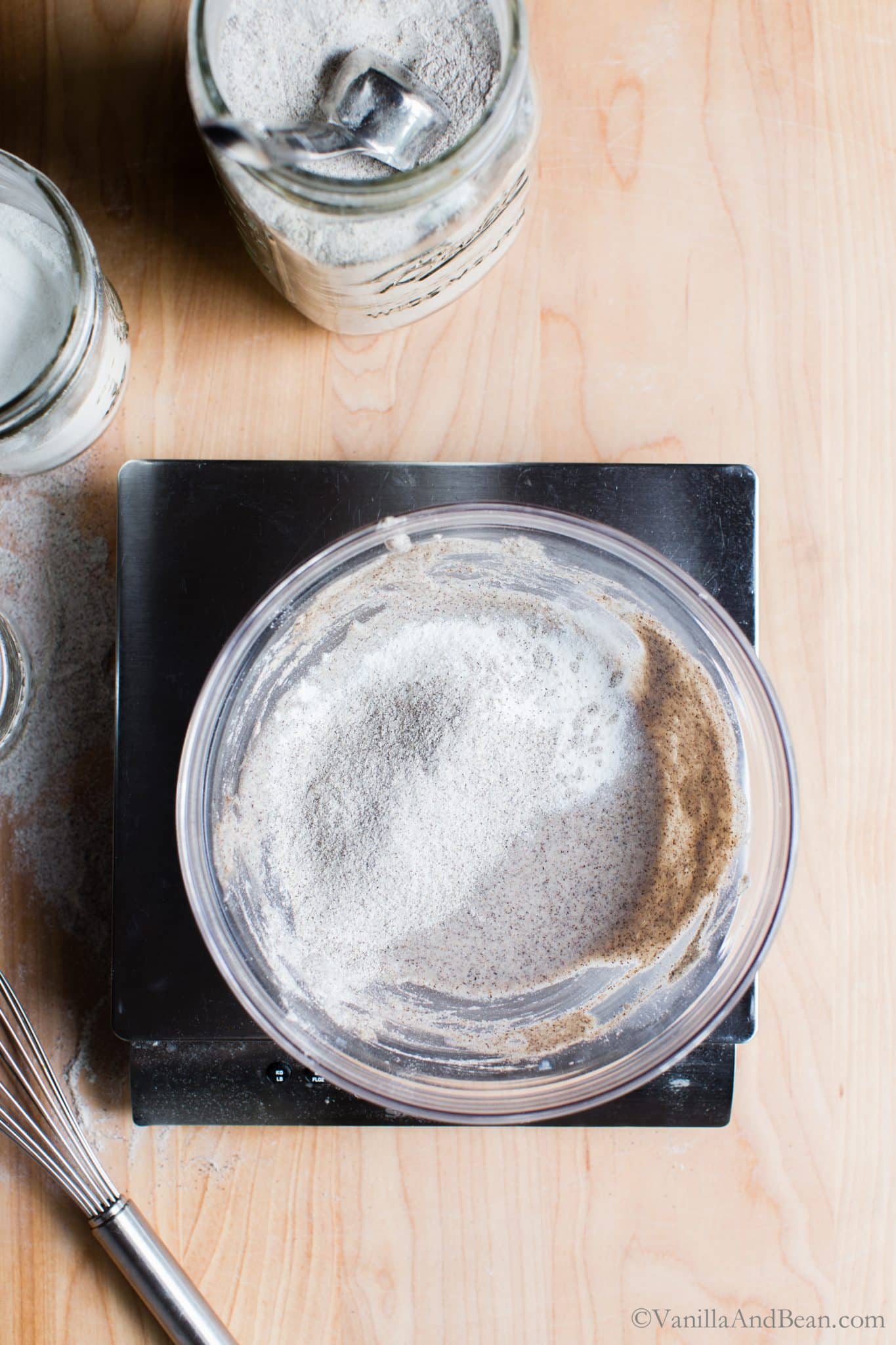
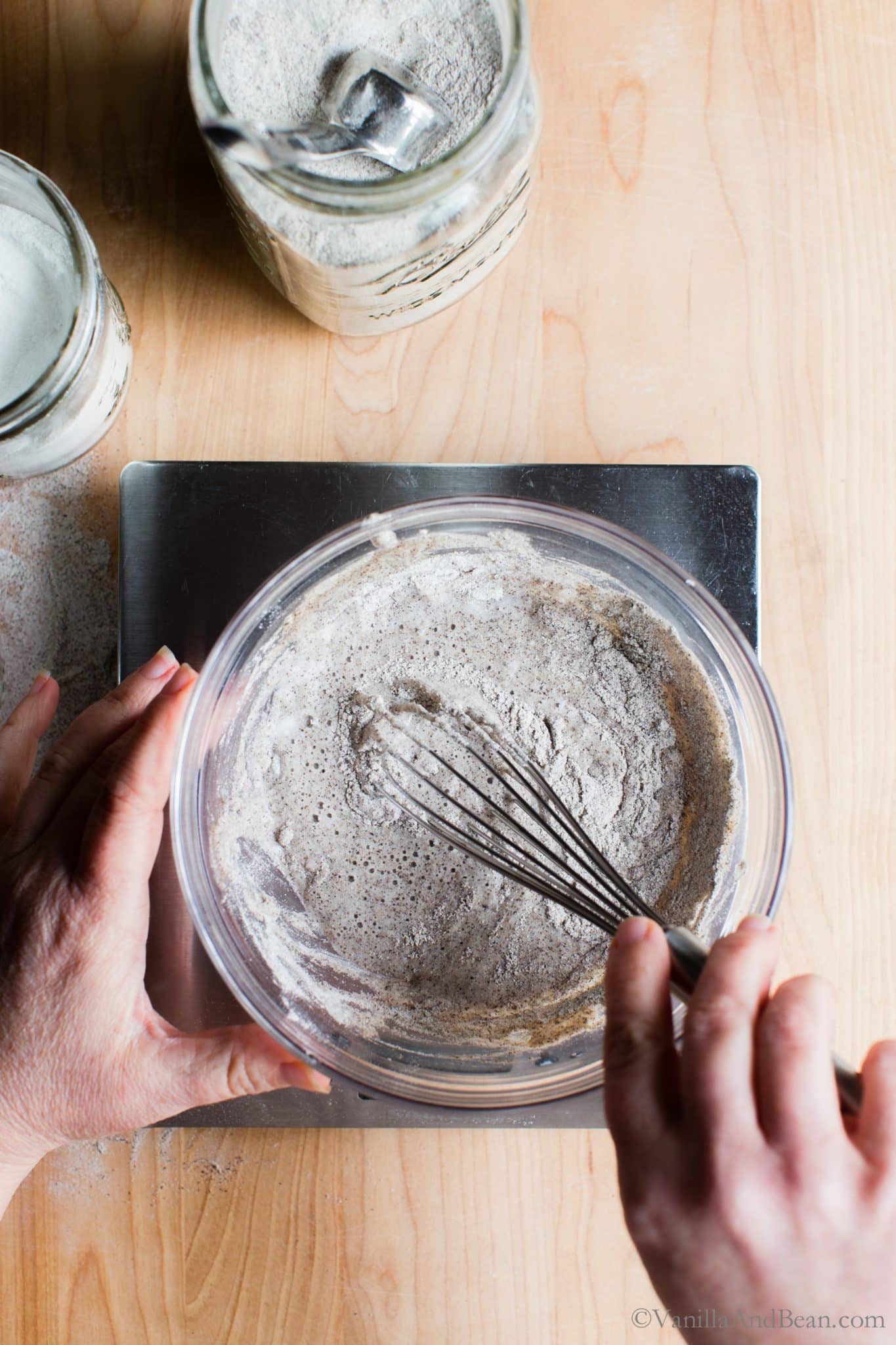
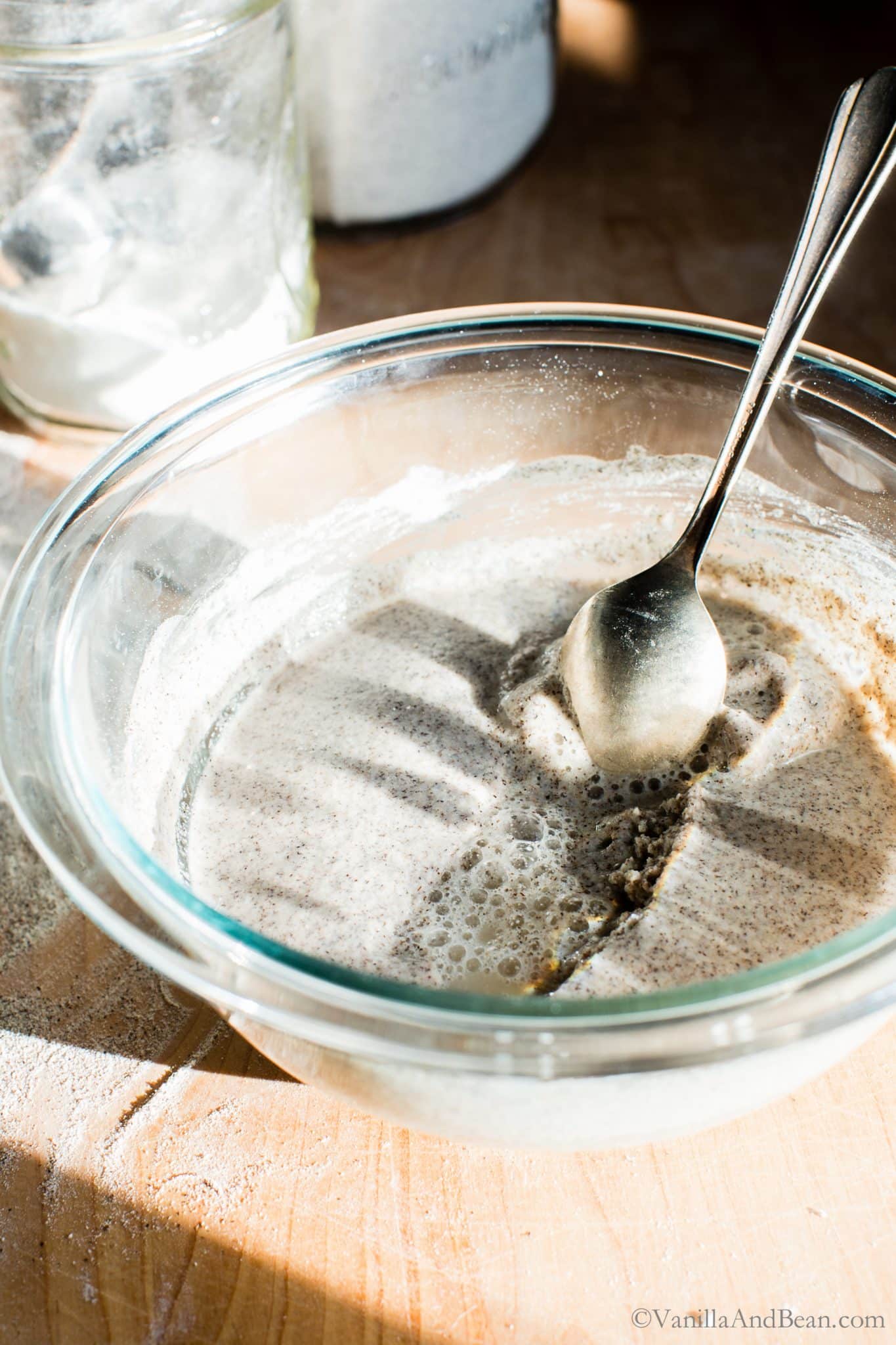
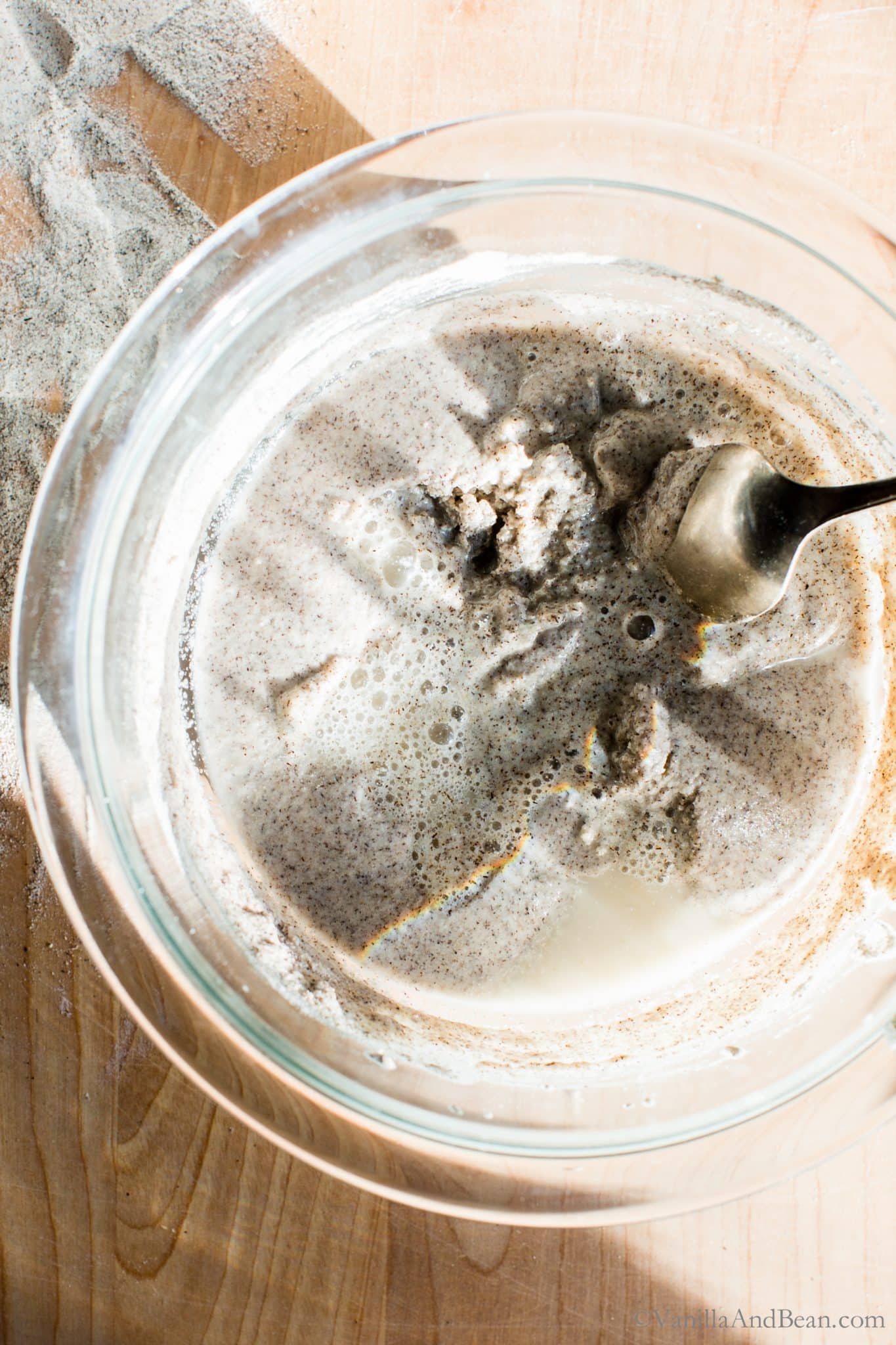
How to Refresh a Gluten Free Sourdough Starter
Refreshing a gluten free starter keeps it healthy and strong. I refresh mine at least every other week, once a week if I remember, when stored in the fridge, but always 8-12 hours before I’m ready to mix the sourdough. Also, I keep the starter in a glass jar with a rubber band around the starting level (after I refresh it) so I can track its progress as it develops.
To Refresh Your Starter
- First, in a clear jar you’ll add part of your sourdough starter (throw out or save the leftover to make gluten free sourdough pancakes or sourdough waffles using your discard). Then you’ll whisk in the water and add the flours. Mix well until the flours are hydrated.
- Next, loosely lid and wrap a rubber band around the jar at the height of the starter. This will give you a visual indication of how much the starter has grown as it grows to double in size.
- Last, allow the starter to develop at room temperature for about 8-12 hours. The time will vary due to ambient temperature.
How do I Know When My Gluten Free Starter is Ready
Once the starter has doubled in size, is bubbly and has a sweet-sour aroma, it’s ready to use in your gluten free sourdough bread recipe. After measuring out the portion needed for your recipe, refresh the starter, as indicated above and store in the fridge until your next feeding.
The starter will not stay in this doubled in size state for long. At some point after doubling in size, it will begin to lose its strength and fall. The exact amount of time will vary from starter to starter but I’ve typically observed a few hours window, at room temperature, where the starter will remain doubled in size. On warm days, it’s shorter. But in the refrigerator, it’ll hold for quite a while. I’ve observed at least over eight hours! Once it starts falling back down after doubling in size, you’ll need to refresh (or feed) it and allow it to double in size again before using it in a sourdough bread recipe.
If your starter is struggling to double in size, you’ll need to go through a few cycles of refreshment to build strength in the starter. You can even refresh twice within a 12 hour period if needed. Doing this builds flavor and will help later in the development of your gluten free sourdough bread. I do a series of refreshments after freezer storage or a long period of neglect in the refrigerator before using it in a recipe.
How Do I Maintain my Gluten Free Sourdough Starter?
Think of your sourdough starter as a refrigerator pet that needs regular attention. There’s yeast and bacteria that make up the starter so it needs to be fed (refreshed) on a regular basis. Your starter can be stored at room temperature if you’re baking daily.
However, I use mine about once every two weeks, so I store my starter in the refrigerator. I’ve gotten away with refreshing it only before and after I bake and this system of an every other week feeding/baking schedule works well for me. In a perfect world, it should be fed weekly.
What is That Layer of Liquid?
Sometimes while you’re building your starter and/or after your starter is established, you may notice a layer of liquid that forms on the surface. This liquid is called hooch, a naturally occurring alcohol which indicates your starter is hungry, that it’s a little past time to feed your starter and is an indication of a weak (hungry) starter. Hooch should have a pleasant sweet-sour aroma. You can pour it off or stir it into your starter and carry on with refreshment.
If you notice hooch after refreshing your starter, and you’ve missed the doubled in size bake window, you’ll need to feed your starter twice a day, about every eight hours, which will remedy hooch and build strength in your starter. Putting your starter in a cooler area of the house should help too. This will slow down the fermentation process.
If you’ll be away from baking for a while and need to store your starter longer than a few weeks, it can go in the freezer. When ready to use it again, thaw it out in the refrigerator and refresh it a few times prior to baking with it.
Remember, your starter is ready when it doubles in size, is bubbly and has a pleasant sweet-sour aroma.
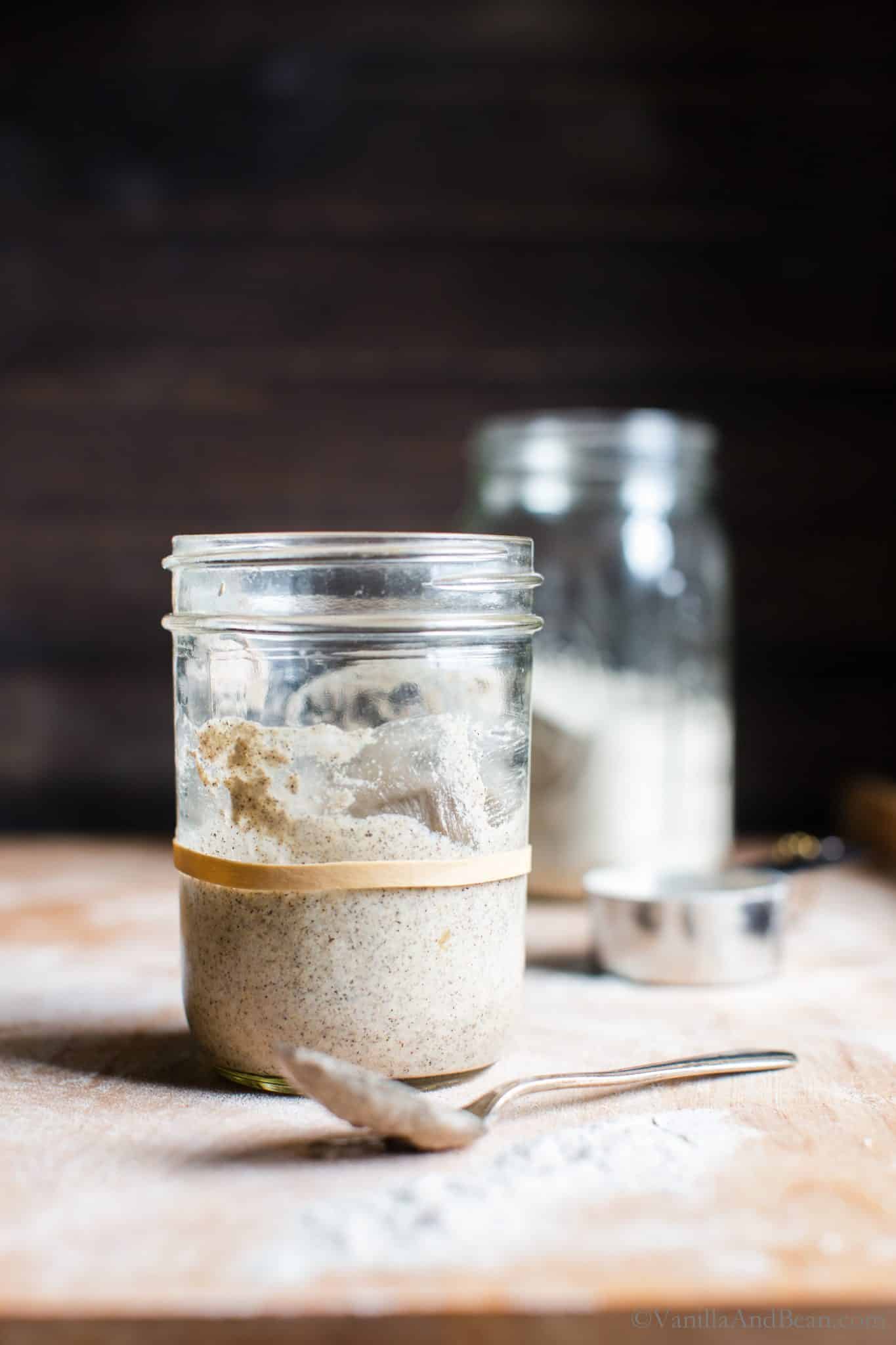
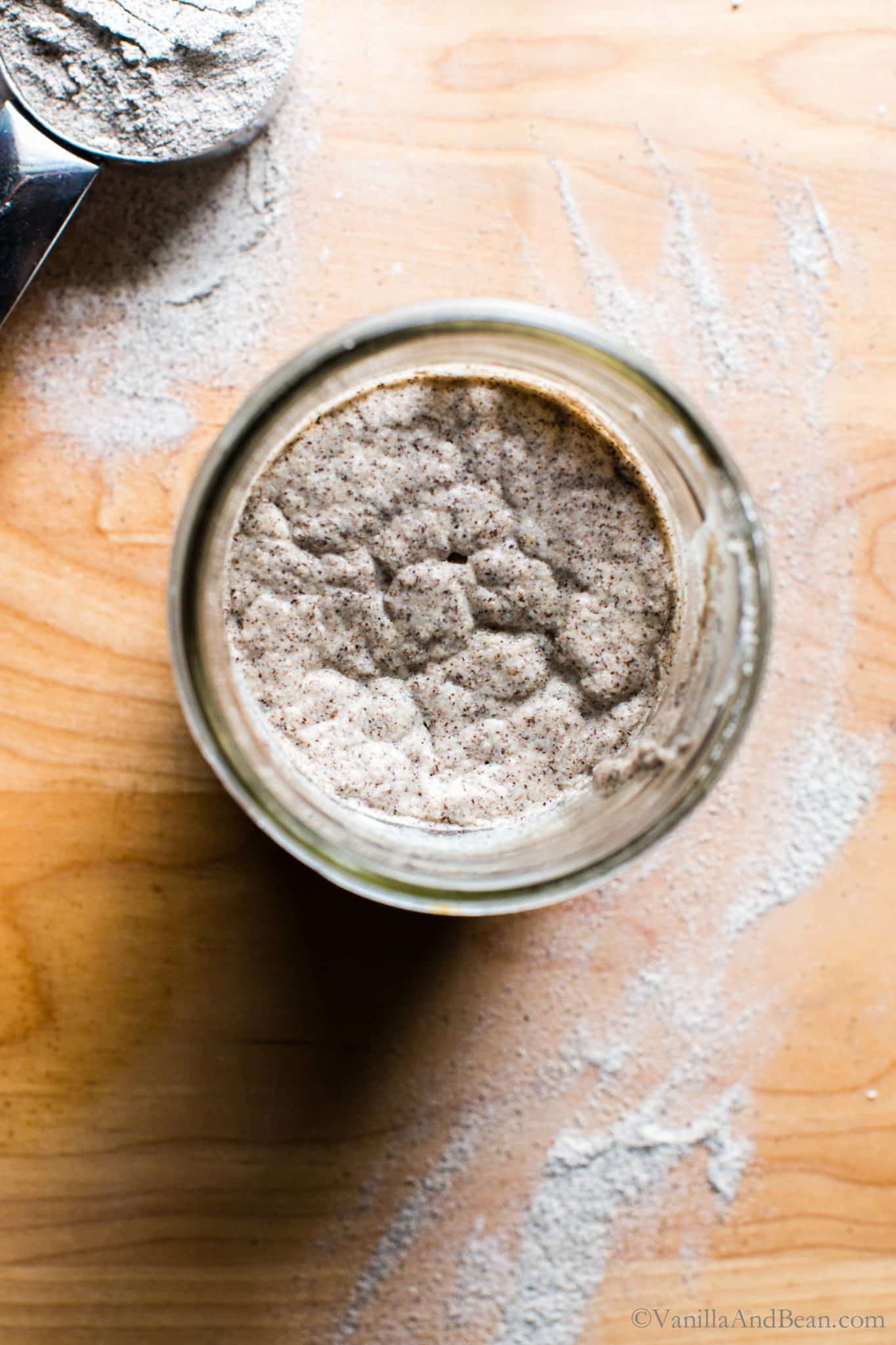
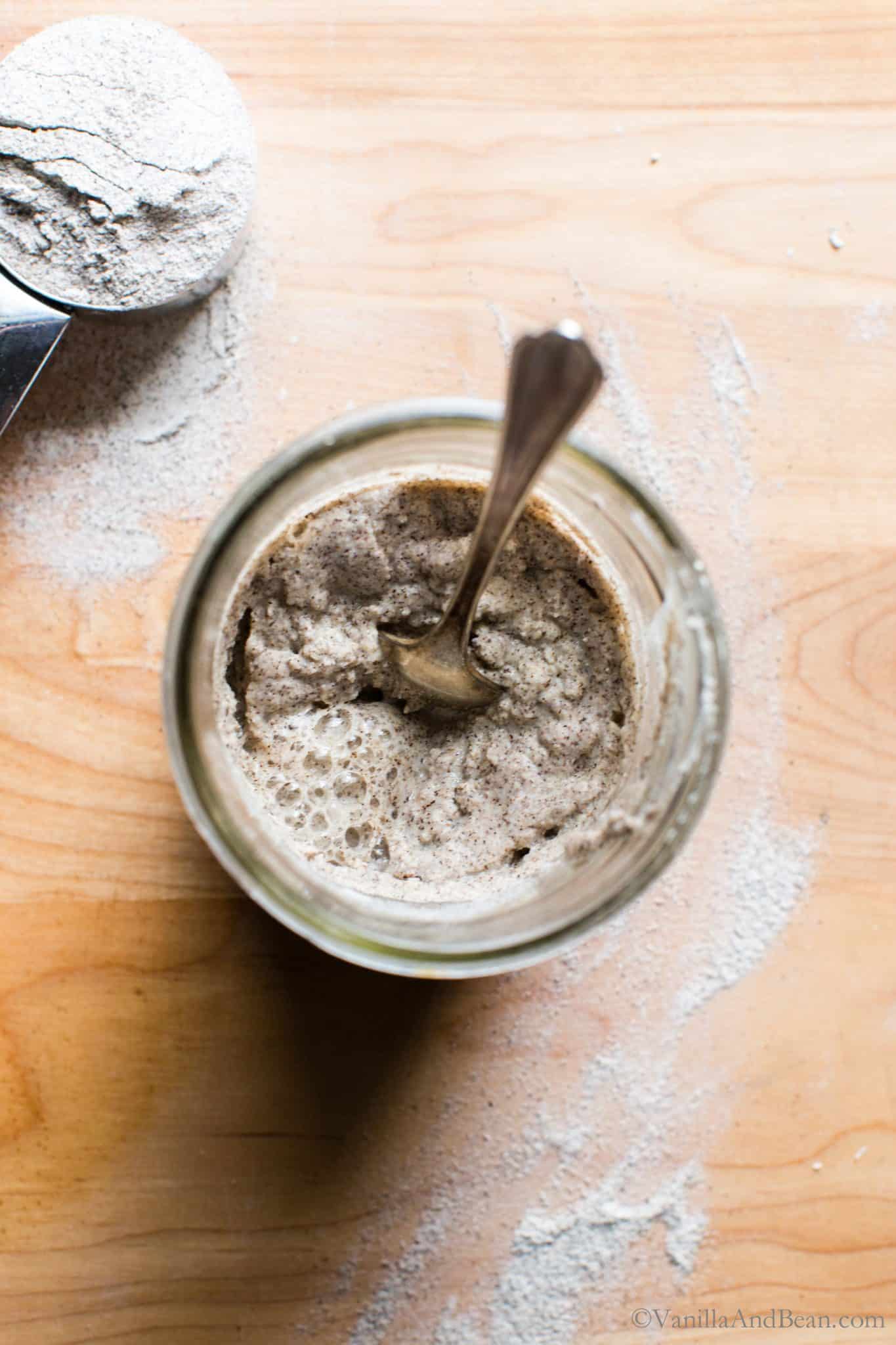
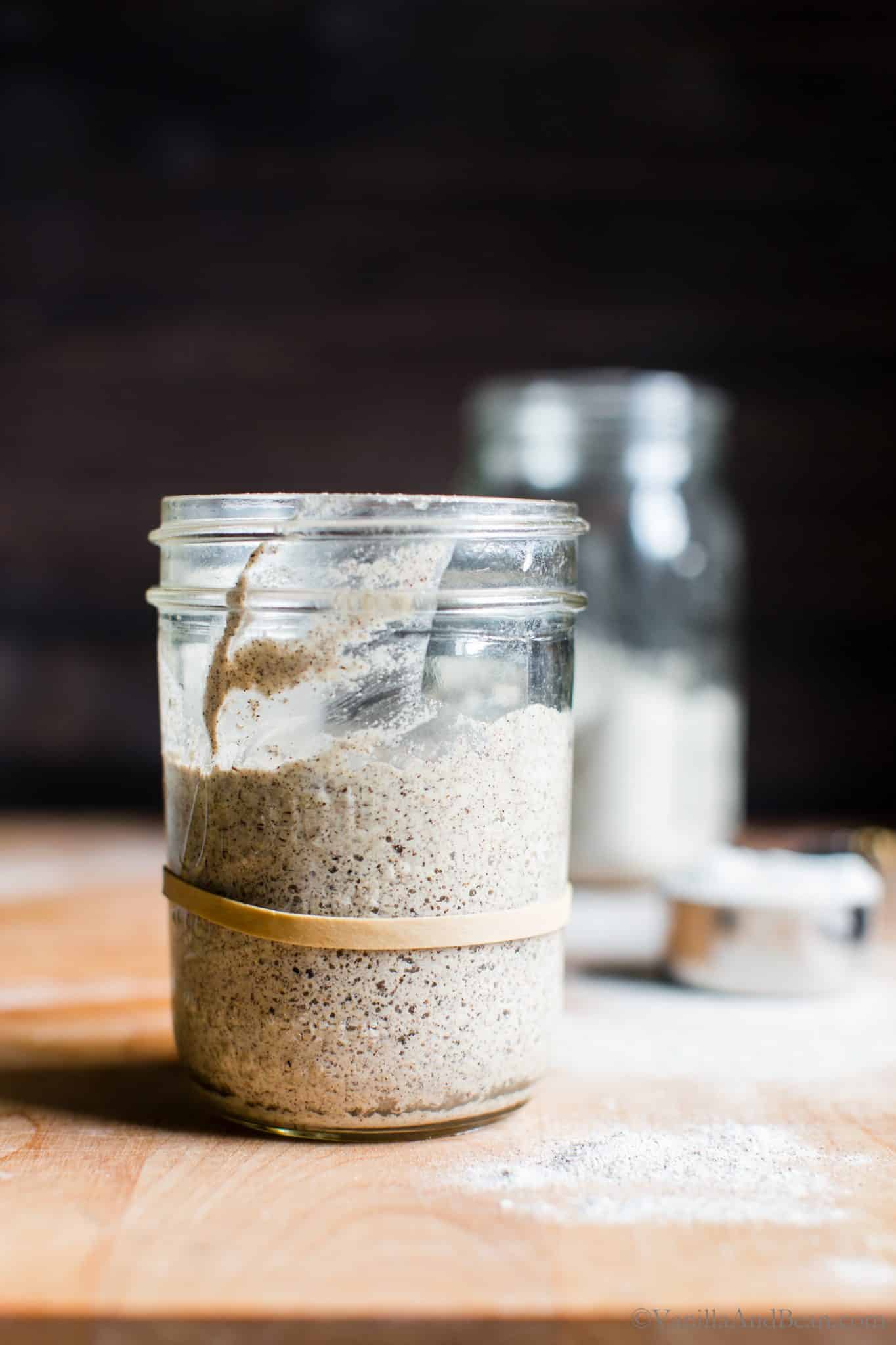
Expert Tips
- Time is a guide rather than a determining factor for when the starter is ready. Use the cues and your senses to determine when it’s ready. It may take longer than seven days. It’s ready when it’s ready.
- For leftover sourdough starter (discard), you can keep it in a jar for use in other recipes, give some away or throw it out. It can be used in gluten free sourdough pancakes, sourdough waffles or my gluten free sourdough pizza crust recipe without having to double it in size… and it’s absolutely delicious! I keep a jar in my refrigerator and refill it as I discard the leftover starter at refreshment time. The discard can be frozen too.
- If you see any mold or a layer of pinkish/orange/white slimy color on the top of your starter, throw it out and make a new starter. This can be avoided simply keeping your starter happy and well fed, refreshing it weekly in the fridge or daily at room temperature.
- Through testing this recipe, I found sweet white rice flour or AP 1-1 gluten free baking flour to be an essential component in developing a strong and consistent gluten free sourdough starter. Mixed with another whole grain flour such as buckwheat or brown rice flour yields consistent results. These are the only two whole grain flours I’ve tried when making this starter. If you use something different, please let us know how it goes in the comments!
- Float Test: If you’re a glutenous sourdough baker and have used the float test in the past to observe when your sourdough starter is ready, the same idea doesn’t work for gluten free sourdough starter. So, you’ll need to go on observation alone. Remember: the starter doubles in size, smells of a sweet-sour aroma and has air pockets within the starter (or is bubbly).
RELATED: Once your gluten free starter is going, check out my Seeded Multigrain Gluten Free Sourdough Bread. Use your discard in these GF Sourdough Pancakes, GF Sourdough Pizza Crust and in GF Sourdough Waffles!
UPDATE (2/20): If you’re on Instagram, I’ve recorded a day by day video so you can see how the starter progresses over time! Link to my profile on Instagram, then look for GF SD Start… in Highlights!
Gluten Free Sourdough Starter
Ingredients
- Buckwheat Flour or Brown Rice Flour
- Sweet White Rice Flour or AP 1-1 gluten free baking flour
- Water room temperature **see note
Instructions
- Day One: In a medium glass bowl or jar, whisk together 2 T (20g) buckwheat or brown rice flour, 2 T (20g) sweet rice flour and 1/4 C (60g) of water. Cover with a damp tea towel and rest at room temperature for 24 hours.
- Day Two: In a clean medium glass bowl or jar, whisk 2 T (40g) of mixture you made yesterday (throw out the leftovers), 2 T (20g) buckwheat or brown rice flour, 2 T (20g) sweet rice flour and 1/4 C (60g) of water. Cover with a damp towel or loose fitting lid and rest at room temperature for 24 hours.
- Day Three Through Day Six or Seven (or beyond): Repeat step two using the previous days starter until the mixture becomes puffy, has a pleasant sweet-sour aroma and bubbles begin or air pockets are visible under the surface. This process takes about six to seven days (as this has been my experience) - but it may take longer. Time is not a determining factor for when the starter is ready, it's simply a guide. It's ready when it's ready. Use the cues and your senses to determine when your starter is ready. This is the nature of sourdough. Before using your new starter in a recipe, you'll need to refresh (feed) it.
How to Refresh your Gluten Free Sourdough Starter:
- Once you have an established starter, you'll need to feed it.In a clean lidded jar, add 1/4C (60g) of sourdough starter (throw out or save the leftover 'discard'). To the starter, mix in 1/3 C (80g) room temperature water. Add 3 T (30g) buckwheat flour and 3 T (30g) sweet white rice flour to the water mixture. Mix well until the flours are hydrated. Wrap a rubber band around the jar at the height of the starter. This will give you a visual indication of how much the starter has grown. Put a lid on the jar (it doesn't need to be loose - just regular) and allow the starter to develop at room temperature for about 8-12 hours* or until it doubles in size. The time will vary due to ambient temperature.If your starter is struggling to double, place it somewhere warm, like inside a turned off oven with a light on. You can also try feeding twice a day to nudge the starter along.Once the starter has doubled in size, is bubbly, and has a sweet-sour aroma, it's ready to use in your gluten free sourdough bread recipe.After measuring out the portion needed for your recipe, refresh the starter, as indicated above and store it until ready to use again.
How to Store Your Starter:
- Room Temperature: The starter can be stored at room temperature if you bake daily, which also means it will be need to be refreshed daily. Store it in a glass jar with a lid. Refrigerator: Ideally, you'll want to refresh your starter (feed it) each week if stored in the refrigerator. When preparing for mixing, and after pulling the starter from the fridge, you may need to refresh it twice within a 12 hour period to get it going again. This is not always the case, but sometimes the starter can be sluggish. Store it in a glass jar with a lid. Freezer: For longer storage, place your starter in the freezer. It will revive after it thaws in the refrigerator and goes through a few refreshments. Store it in a glass jar with a lid.
How to Store Your Discard if Saving:
- Once you have an established starter, you can use it for bread, and your discard for pancakes, waffles, pizza and other recipes to add that tangy sourdough flavor. Store it in the fridge, in a lidded glass jar, for up to two weeks. You may see a layer of hooch, and this is not unusual. You can pour it off or stir it in. If you see any white, orange or pink film or mold, toss it. You can also store your discard in the freezer for longer storage. Thaw it in the fridge before using in a recipe.






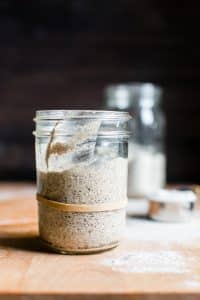
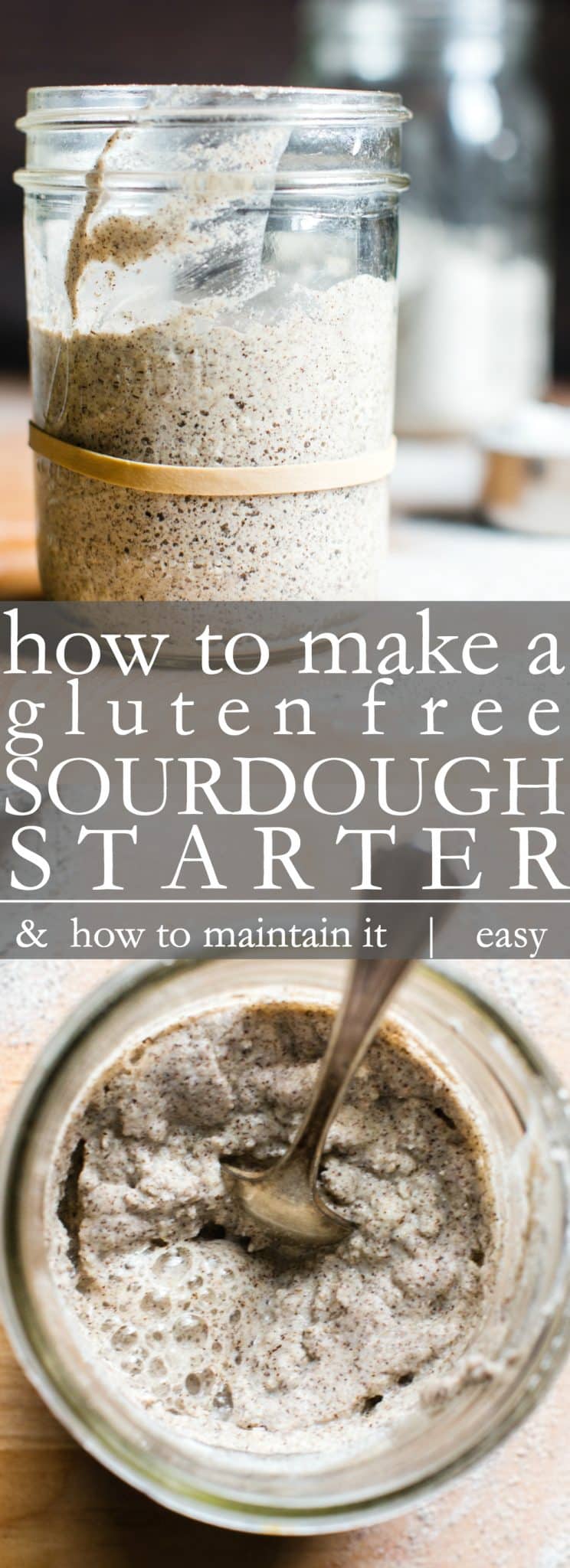
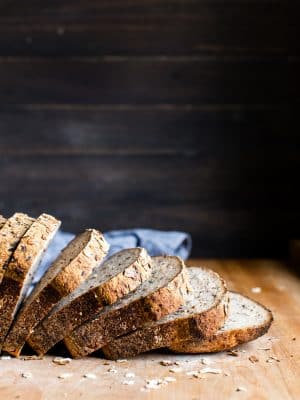


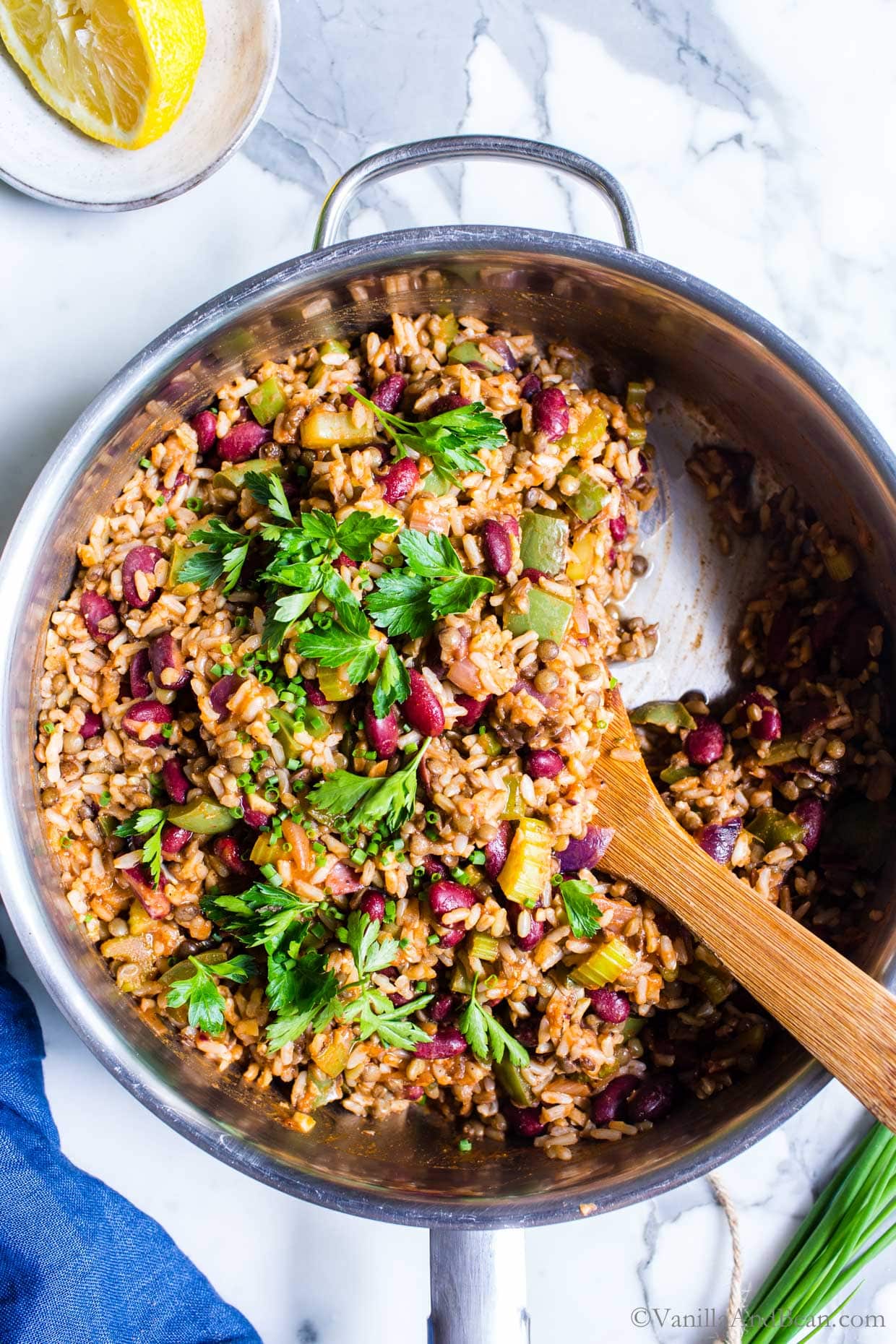



Hi Traci,
I’m on day 2 of the starter. I was reading about feeding it, once it’s established, and I noticed that buckwheat flour is called for and the option to use brown rice flour is no longer listed as an option to use. Will you please clarify this for me?
Thanks so much, I’m really looking forward to trying this out!
Hi Mari! You can use brown rice flour if you like. I have typically used buckwheat when refreshing/feeding because I have usually have more of it on hand. Keep us posted with your starter!
Thanks for your quick reply. I ought to have asked you if you think it’s a better flavor using buckwheat(?)
I do prefer buckwheat. Plus it’s always at the ready for pancakes!
Aloha, Traci, I started my first attempt with your recipe on Tuesday afternoon using sweet white rice flour and buckwheat flour. On Wednesday afternoon, there was a bit of hooch on top, so I mixed it in and combined 2T with the amount in the instructions for day 2. It smelled slightly tart and it made me happy. Then, this morning (Thursday), when I came out to the kitchen, there was a layer of pink liquid on top. :(
I’m not sure what went wrong, so I’m trying again. It’s been about 6 hours, and there is a layer of water/hooch on top––is it too soon to do a refresh?
And, I was wondering about the damp towel––does the towel need to stay damp? Maybe because it’s winter and dry in our home, the towel dries up before I go to bed.
Lastly, have you ever left your starter somewhere other than the kitchen and found success? I wonder if the constant cooking/baking/roasting negatively impacts the starter or not.
Thank you so much, Traci.
Aloha Ree! That layer of liquid indicates a hungry starter, meaning it’s exhausting it’s food supply before it’s fed again. You can put it somewhere consistently cooler as warmer temperatures speed the process up, or try feeding it two times a day. Feeding it several times a day will ensure it’s not running out of food! Warmer temperatures (cooking/baking/roasting nearby) will increase the speed at which your starter exhausts the fresh flour you recently fed it. Also, be sure to use a new, clean vessel each time you feed. Last, the towel needs to stay damp, so you can double up – since it’s dry in your home. Keep us posted and let me know if you have any other questions!
Thank you so much for the reply, Traci. I noticed that the “hooch” starts to develop just 15-20 minutes after I refresh the starter––do you recommend I add less water?
I’ve been reading about “hydration”, but since math is not my strong suit––and neither is science––I’m wondering if this recipe is over hydrated for my specific environment?
Mahalo!
I’ve never seen hooch develop that quickly. Usually it takes at least 12-24 hours, so I’m not sure what’s going on. You could try letting the starter develop in the refrigerator, although it will take much longer to create a starter and also, double in size.
Thank you, Traci. I will try that if I fail again with this second attempt.
Update: I fed it twice yesterday, but before I went to bed, there was a huge layer of hooch on top. Then, this morning I saw that there were bubbles and (the layer of hooch was at the bottom instead of at the top), so fingers crossed it will work this time around. If not, I’ll try growing it in the fridge.
Thanks for all of your help!
Hi Traci, I am here to report that my sourdough starter FINALLY … started? And I’ve made your pancakes, along with focaccia, naan, and muffins. Thanks so much for all of your help. In case it helps others, I want to share that my starter really took off when I named her (lol).
Best news ever! Thank you Rée!